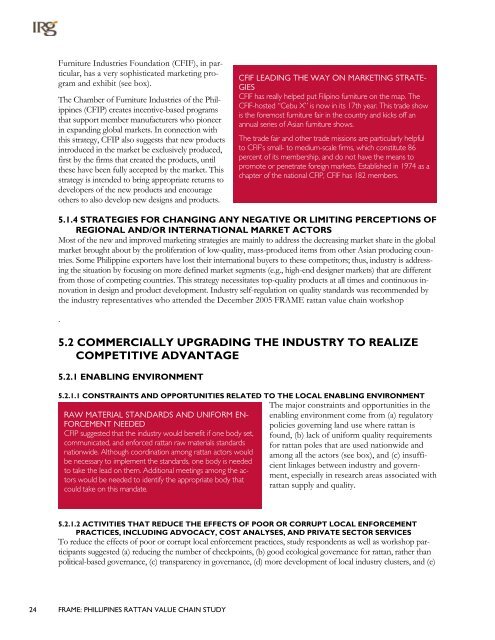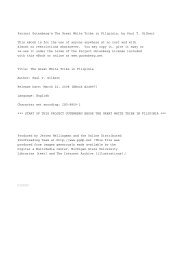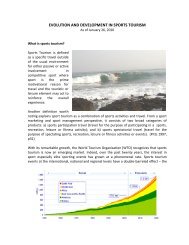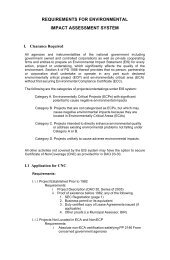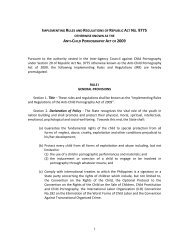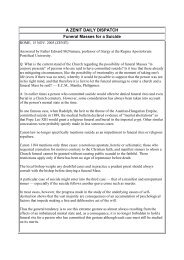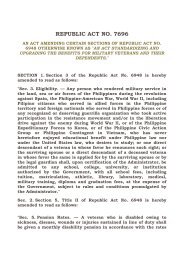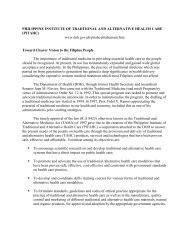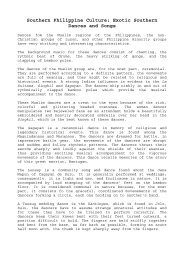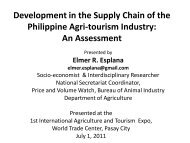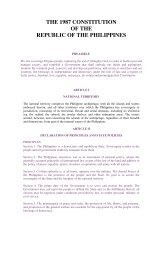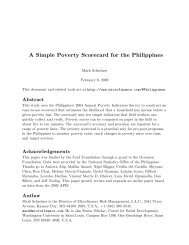PHILIPPINES RATTAN VALUE CHAIN STUDY - About the Philippines
PHILIPPINES RATTAN VALUE CHAIN STUDY - About the Philippines
PHILIPPINES RATTAN VALUE CHAIN STUDY - About the Philippines
You also want an ePaper? Increase the reach of your titles
YUMPU automatically turns print PDFs into web optimized ePapers that Google loves.
Furniture Industries Foundation (CFIF), in particular,<br />
has a very sophisticated marketing program<br />
and exhibit (see box).<br />
The Chamber of Furniture Industries of <strong>the</strong> <strong>Philippines</strong><br />
(CFIP) creates incentive-based programs<br />
that support member manufacturers who pioneer<br />
in expanding global markets. In connection with<br />
this strategy, CFIP also suggests that new products<br />
introduced in <strong>the</strong> market be exclusively produced,<br />
first by <strong>the</strong> firms that created <strong>the</strong> products, until<br />
<strong>the</strong>se have been fully accepted by <strong>the</strong> market. This<br />
strategy is intended to bring appropriate returns to<br />
developers of <strong>the</strong> new products and encourage<br />
o<strong>the</strong>rs to also develop new designs and products.<br />
CFIF LEADING THE WAY ON MARKETING STRATE-<br />
GIES<br />
CFIF has really helped put Filipino furniture on <strong>the</strong> map. The<br />
CFIF-hosted “Cebu X” is now in its 17th year. This trade show<br />
is <strong>the</strong> foremost furniture fair in <strong>the</strong> country and kicks off an<br />
annual series of Asian furniture shows.<br />
The trade fair and o<strong>the</strong>r trade missions are particularly helpful<br />
to CFIF’s small- to medium-scale firms, which constitute 86<br />
percent of its membership, and do not have <strong>the</strong> means to<br />
promote or penetrate foreign markets. Established in 1974 as a<br />
chapter of <strong>the</strong> national CFIP, CFIF has 182 members.<br />
5.1.4 STRATEGIES FOR CHANGING ANY NEGATIVE OR LIMITING PERCEPTIONS OF<br />
REGIONAL AND/OR INTERNATIONAL MARKET ACTORS<br />
Most of <strong>the</strong> new and improved marketing strategies are mainly to address <strong>the</strong> decreasing market share in <strong>the</strong> global<br />
market brought about by <strong>the</strong> proliferation of low-quality, mass-produced items from o<strong>the</strong>r Asian producing countries.<br />
Some Philippine exporters have lost <strong>the</strong>ir international buyers to <strong>the</strong>se competitors; thus, industry is addressing<br />
<strong>the</strong> situation by focusing on more defined market segments (e.g., high-end designer markets) that are different<br />
from those of competing countries. This strategy necessitates top-quality products at all times and continuous innovation<br />
in design and product development. Industry self-regulation on quality standards was recommended by<br />
<strong>the</strong> industry representatives who attended <strong>the</strong> December 2005 FRAME rattan value chain workshop<br />
.<br />
5.2 COMMERCIALLY UPGRADING THE INDUSTRY TO REALIZE<br />
COMPETITIVE ADVANTAGE<br />
5.2.1 ENABLING ENVIRONMENT<br />
5.2.1.1 CONSTRAINTS AND OPPORTUNITIES RELATED TO THE LOCAL ENABLING ENVIRONMENT<br />
The major constraints and opportunities in <strong>the</strong><br />
RAW MATERIAL STANDARDS AND UNIFORM EN- enabling environment come from (a) regulatory<br />
FORCEMENT NEEDED<br />
policies governing land use where rattan is<br />
CFIP suggested that <strong>the</strong> industry would benefit if one body set, found, (b) lack of uniform quality requirements<br />
communicated, and enforced rattan raw materials standards for rattan poles that are used nationwide and<br />
nationwide. Although coordination among rattan actors would among all <strong>the</strong> actors (see box), and (c) insufficient<br />
linkages between industry and govern-<br />
be necessary to implement <strong>the</strong> standards, one body is needed<br />
to take <strong>the</strong> lead on <strong>the</strong>m. Additional meetings among <strong>the</strong> actors<br />
would be needed to identify <strong>the</strong> appropriate body that<br />
ment, especially in research areas associated with<br />
could take on this mandate.<br />
rattan supply and quality.<br />
5.2.1.2 ACTIVITIES THAT REDUCE THE EFFECTS OF POOR OR CORRUPT LOCAL ENFORCEMENT<br />
PRACTICES, INCLUDING ADVOCACY, COST ANALYSES, AND PRIVATE SECTOR SERVICES<br />
To reduce <strong>the</strong> effects of poor or corrupt local enforcement practices, study respondents as well as workshop participants<br />
suggested (a) reducing <strong>the</strong> number of checkpoints, (b) good ecological governance for rattan, ra<strong>the</strong>r than<br />
political-based governance, (c) transparency in governance, (d) more development of local industry clusters, and (e)<br />
24 FRAME: PHILLIPINES <strong>RATTAN</strong> <strong>VALUE</strong> <strong>CHAIN</strong> <strong>STUDY</strong>


